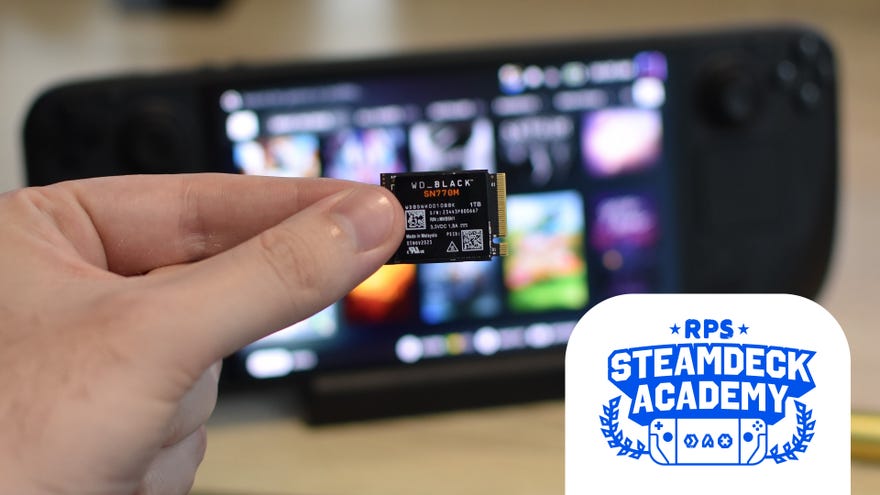How to install a new SSD on the Steam Deck
Venture inside your Deck to make a permanent storage upgrade
Here’s the thing: I’ll gladly show you how to install an SSD in a Steam Deck, but be warned that it’s by far the trickier of your two storage upgrade options. Whereas adding a microSD card is as easy as pushing it into the dedicated slot, swapping out the Deck’s internal drive involves fiddling with some seriously sensitive components. It’s not for the faint of heart nor the shaky of hand, and unlike the majority cool things you can do with Valve’s handheld PC – be it adding fun plugins with Decky Loader or unleashing its versatile Desktop Mode – swapping the SSD does require a fair few tools.
All that said, upgrading the SSD does make a bit more sense today than it did when the Steam Deck first launched. Mainly because there are actually now some decent SSDs to choose from; back in 2022, solid state drives that came in the Deck-friendly M.2 2230 form factor were both rare and expensive. Now, likely driven by the growth of both the Steam Deck and its Windows-based rivals (like the Asus ROG Ally), 2230 SSDs are widely available, and sometimes even cheaper than an equivalently-sized microSD card. Because some kind of SteamOS magic keeps the latter performing quickly in most games, I still reckon they’re ideal for most Deck owners, but if you’re willing and able to crack yours open, then installing a whole new SSD has become a more viable alternative. And more appealing, if you went for a 64GB or 256GB Steam Deck model and quickly found yourself running low on game space.
This guide will cover both the SSD upgrade itself, and the process for installing a fresh copy of SteamOS once it’s in place. Note that LCD-screened Steam Decks won’t all have exactly the same internal design, as Valve rejigged it very slightly in 2023, and the Steam Deck OLED has yet another unique layout of its own. Nonetheless, I’ve written this guide as such that all three should be covered.
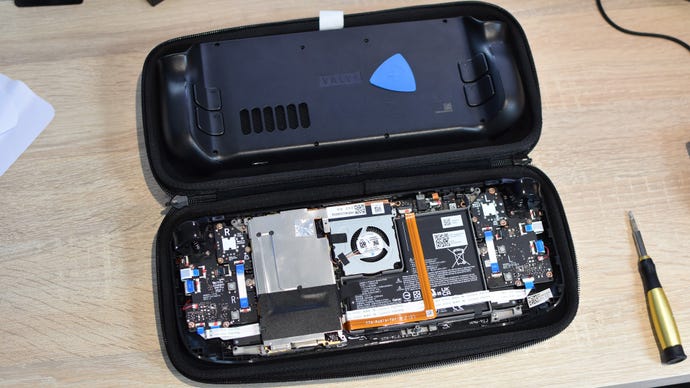
How to install a new SSD on the Steam Deck: What you’ll need and prep steps
As forewarned, changing the SSD on a Steam Deck is trickier than installing an SSD in a desktop. Full-sized PC parts can be surprisingly sturdy, but the Steam Deck was never really intended to be poked around in, so we’re going to be dealing with some preposterously tiny screws, plastic casing that really doesn’t want to budge, and highly fragile components. To name a few things.
Besides the new SSD itself, then, there are few more pieces of kit you’ll need before starting the installation in earnest. I’d recommend you also take a couple of preparatory steps as well:
- Make sure you have the right screwdriver: Depending on which Steam Deck model you have, you’ll need a specific mini-screwdriver head to get inside. For all the original, LCD Decks, get yourself a small (no wider than size 0) Phillips head ‘driver. The Steam Deck OLED, on the other hand, uses six-point star-sharped Torx screws throughout. Again, go for a smaller head size – T6 did the job for me.
- Get a pry tool: Even with all its outside screws removed, pulling the Steam Deck’s backplate is a fingernail-shredding hard time with bare hands. You can make your life a lot easier with a simple plastic pry tool, which you can run around the edges of the rear cover to harmlessly pop it out of its fastening clips. I use the trianglular ones in the iFixit Essential Electronics Toolkit (which, by the by, includes all the screwdriver parts you’ll need as well), though a thick guitar plectrum or a sturdy credit card can work in a pinch. Don’t use anything metal (like a flathead screwdriver), or you’ll damage the casing.
- Clear a USB stick, and make sure you can connect it to your Deck: The method below involves creating SteamOS boot media out of a USB drive, which should be at least 8GB in size. Clear or format it first, and remember that to connect it to the Steam Deck, you’ll also need either a USB-A to USB-C adapter, a USB-C hub, or a Steam Deck dock.
- Run down the battery: Valve have previously recommended that you only open your Deck with a flat battery, but it’s safe enough to just stick the device in Battery Storage mode instead. This prevents you from accidentally switching it on mid-upgrade, though for extra safety, you should first get the Steam Deck’s battery down below at least 80% and ideally below 25%.
- Remove your microSD card, if you have one: The Steam Deck’s microSD slot is positioned as such that an inserted card can stop you from pulling the back cover off. Unless you pull too hard, in which case you could snap your card in half. I know we’re focusing on the SSD here but come on, that’s just harsh.
- Ground yourself: At least some classic PC building advice is applicable here. To minimise the risk of static messing up your Steam Deck, try to wear loose cotton clothing when you do this, and touch a piece of conductive metal beforehand to remove any static you already had on your body.
All sorted? Then enough preamble – let’s get that new SSD in place.
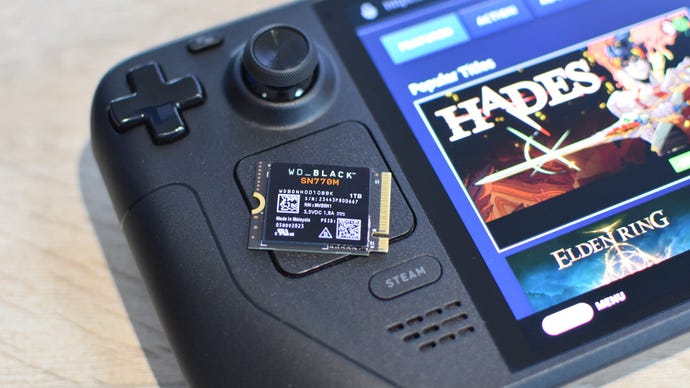
How to install a new SSD on the Steam Deck: step-by-step guide
Step 1: First up, put your Steam Deck into Battery Storage mode, to prevent accidentally powering it on while you’re working on the insides. Start with your Deck switched off, then hold down the Power button and the Volume Up button at the same time to boot into the BIOS. Once you’re in, use either the D-pad or the right trackpad to navigate to Setup Utility, then the Power menu. Select Battery Storage mode and confirm. Now, your Deck will shut down and won’t respond to any pressing of the power button (though don’t worry, we’ll reverse this later).
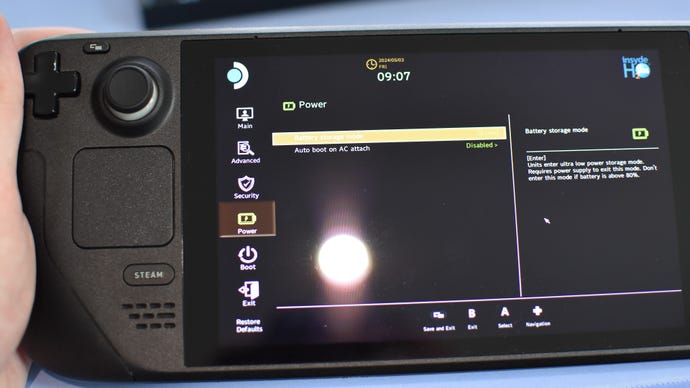
Step 2: Lay out your Steam Deck’s bundled carry case and place the handheld face-down inside, holding it in place without putting any stress on the thumbsticks. Then get to work removing all the screws – on the original Steam Deck, some of these are different sizes, so do keep track of which screws need to go back in which holes. Laying the loose screws out on a table, in the pattern that matches their positions on the Steam Deck, can help. On the Steam Deck OLED, all the screws are identical, so you don’t need to be so careful (beyond not losing any).
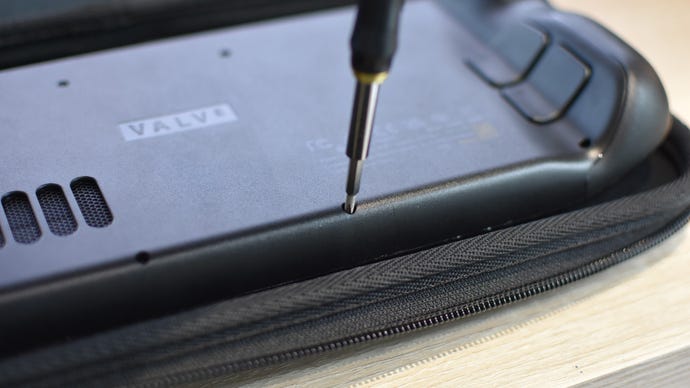
Step 3: With all the screws removed, VERY CAREFULLY remove the Deck’s back cover. This is where a proper pry tool is useful, as you can just work it inside the seam and run it along the edge to slowly push the rear cover away from the body.
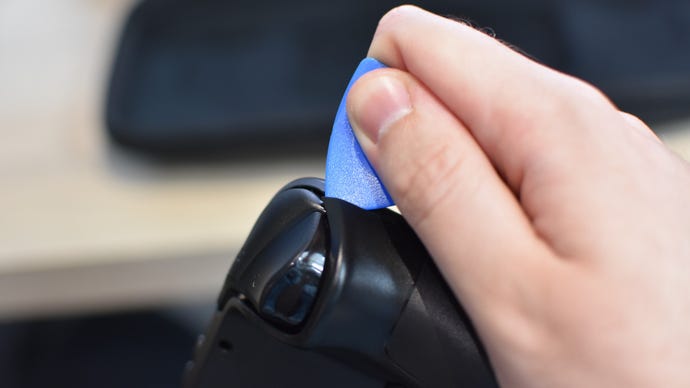
The next step varies depending on which Steam Deck version you have, so OLED owners, skip a paragraph.
Step 4 (LCD Steam Decks): On the left side of the Deck’s internal layout is a large metal plate. On newer models, this should be plain black, with just a couple of small screws holding it in place. On older Decks, it’s silver-coloured, and has a small piece of foil hiding a third screw, so you’ll need to carefully peel this back to access it. In both cases, remove all the screws holding the plate in place, keep them safe to the side, and (also carefully) lift away the plate. Avoid touching any of the thermal pads on the underside as you do so.
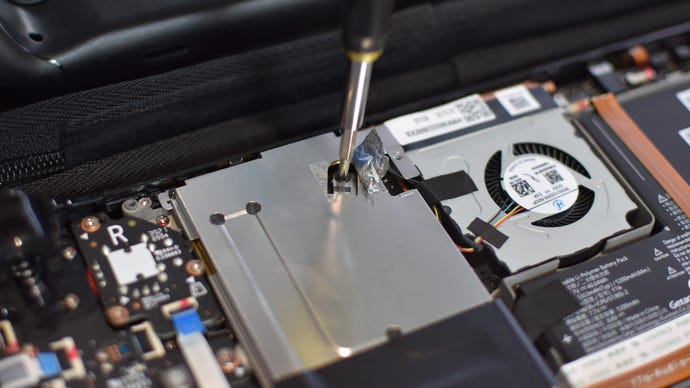
Step 4 (Step Deck OLED): Unlike the LCD models, the plate you’ll need to remove is covered by a ribbon cable, so you’ll need to disconnect that first. Locate the end of the ribbon, just a bit further to the left – the cable should have “C-R” printed on it. Very, very carefully, lift up the white plastic tab holding the ribbon cable in place, then gently pull it out. Then, remove the two Torx screws on the plate itself, lift it up, and gently flip it over to the right. It will still be connected to the ribbon, but that’s fine as long as it’s out of the way.
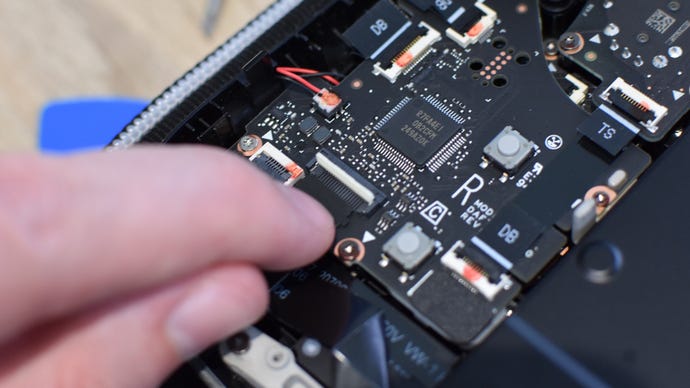
Step 5: Disconnect the battery connector, which was previously hidden by that plate. A pry tool is handy here, as you’ll need to slide the connector out to the side, though this can also be done with a deft fingernail.
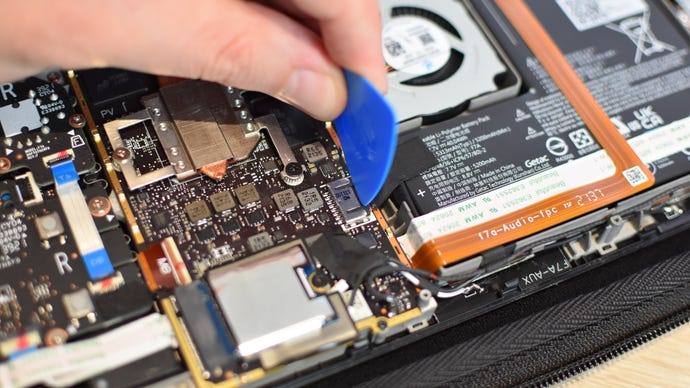
Step 6: Also revealed by the plate’s removal: the SSD! Remove the screw holding it in place (again, don’t lose this, or get it mixed up with the other screws) and lightly pull the SSD, including its protective sleeve, out of the M.2 slot.
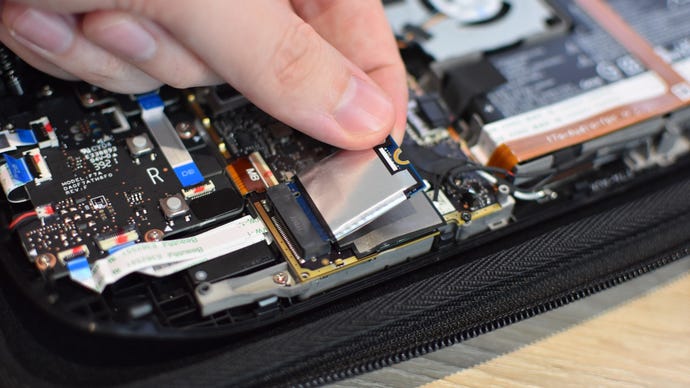
Step 7: Remove that shiny sheath from the old SSD and slide it onto your new drive, in the exact same position. The new drive’s screw cutout and the connecting contacts should both be exposed.
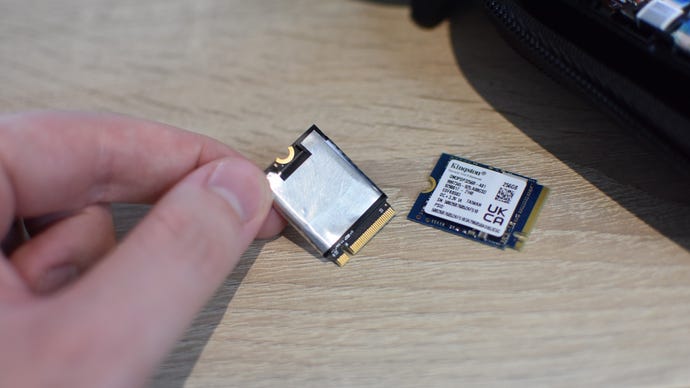
Step 8: Push the new SSD into the M.2 slot, and use the same screw you just removed to fasten it in place.
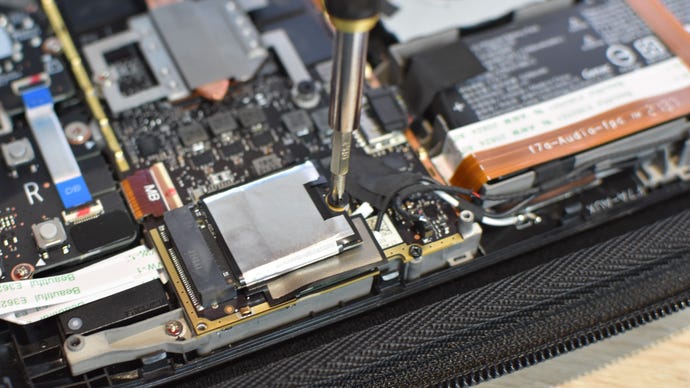
Step 9: Reconnect the battery cable, then replace the metal cover and fasten that down with its screws as well. On older LCD models, re-cover that third screw with the foil.
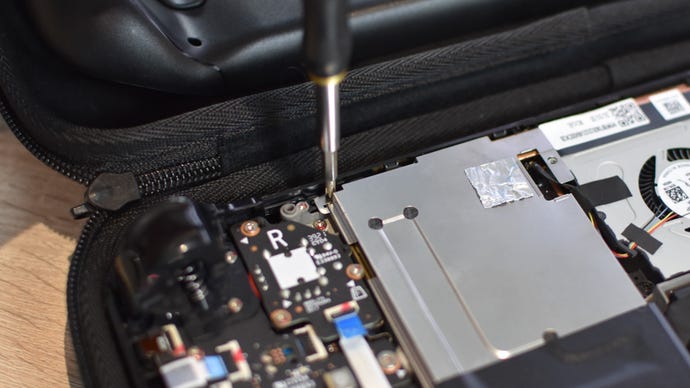
On the Steam Deck OLED, don’t forget to reconnect that ribbon cable too. Slide it in fully, then flip the plastic tab back down to secure it.
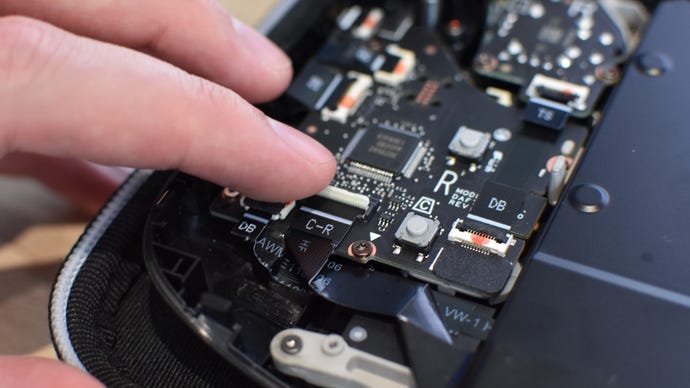
Step 10: Snap the Steam Deck’s backplate back into place, making sure it’s fully clipped together all around, and replace the screws you removed in step 2.
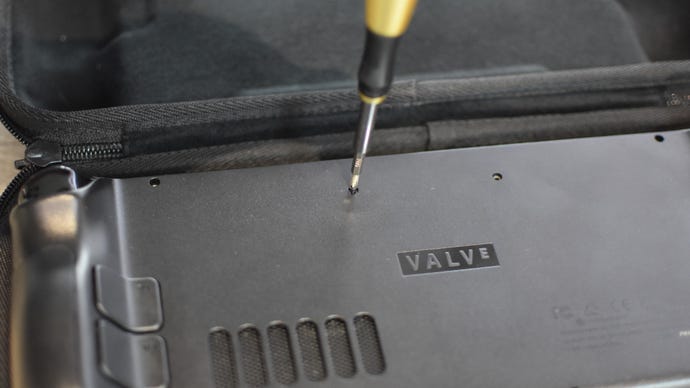
Step 11: Good news! That’s the tricky part done. But you still need to install SteamOS, so on your PC or laptop, head to Valve’s Steam Deck recovery instructions page and download the SteamOS recovery image. You’ll also need an appropriate writing tool to turn your USB stick into a bootable device that the Deck can use – if you’re on a Windows PC, Valve recommend Rufus, as do I.
Once both the recovery image and Rufus are downloaded, plug in your USB drive and run Rufus. It should detect and list your drive in the "Device" field. Just below that, click the "Select" button, navigate to your downloads folder, and select the recovery image (it’s a .bz2 file) to set it as the boot selection. Finally, click "Start" then "OK" to write the SteamOS image to the USB.
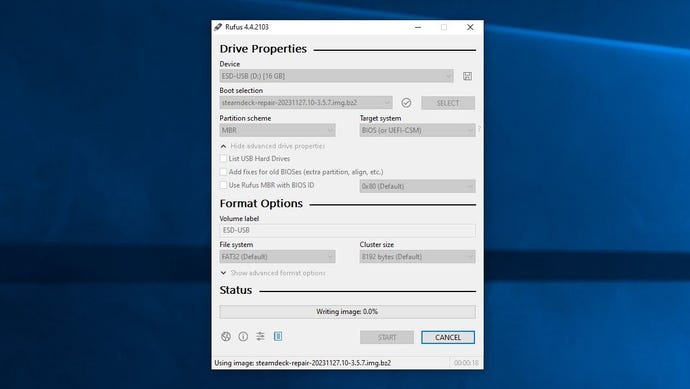
Step 12: Start prepping your Steam Deck for the OS install. First, plug in its charging cable and press the power button – this will have it leave Battery Storage mode. Then, unplug the power and connect a USB-C adapter, hub or docking station, into which you’ve also connected the USB drive with the SteamOS recovery image.
Once everything’s connected, hold down the Volume Down button and press the power button once. After a few moments, your Steam Deck will load up its boot menu. Select the "EFI USB Device" option here.
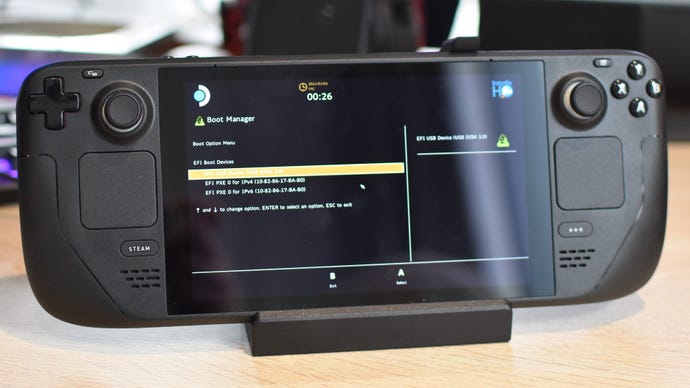
Step 13: Now, wait a bit while SteamOS settles in on your new SSD. At one point you might face a sustained black screen, but resist the urge to reset and just let the installation process play out. Eventually, you’ll arrive on a desktop-like screen. Use the right trackpad to double-click the "Reimage Steam Deck" shortcut here, then click "Proceed" once the dialogue box appears. Finally, after waiting a minute or two for the reimaging to complete, click "Proceed" again.
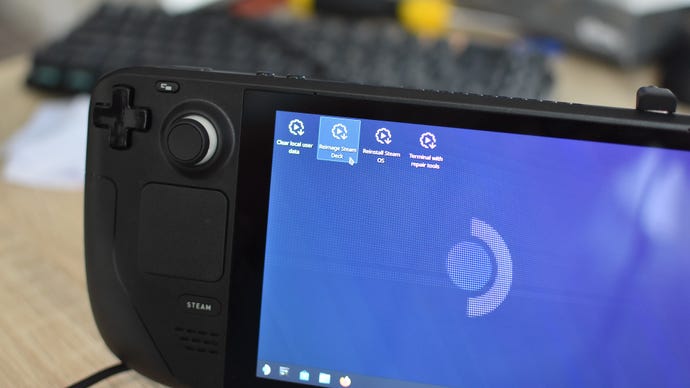
You’ll see a bunch more code on the screen after this, but give the Steam Deck a moment and it will soon reboot into the same standard setup procedure that you encountered when it was fresh out of the box. At this point, you can consider your new SSD installed. Disconnect that USB adapter/hub/dock, get set up, and log into your Steam account. There are games that need installin’.
